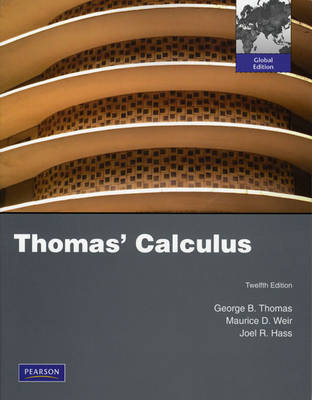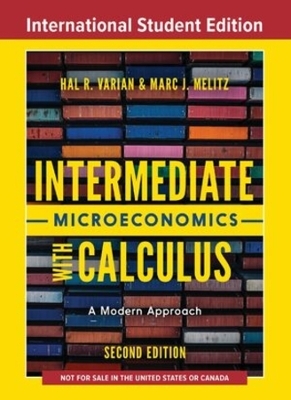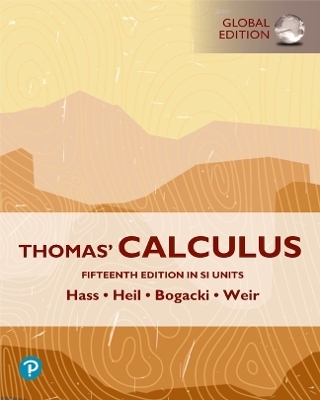
Valuepack:Calculus:Global Edition/MyMathLab Student Acess Card
Pearson Education Limited
978-1-4082-6319-8 (ISBN)
- Titel erscheint in neuer Auflage
- Artikel merken
Calculus hasn't changed, but your students have. Today's students have been raised on immediacy and the desire for relevance, and they come to calculus with varied mathematical backgrounds.
Thomas' Calculus, Twelfth Edition, helps your students successfully generalize and apply the key ideas of calculus through clear and precise explanations, clean design, thoughtfully chosen examples, and superior exercise sets. Thomas offers the right mix of basic, conceptual, and challenging exercises, along with meaningful applications.
This significant revision features more examples, more mid-level exercises, more figures, improved conceptual flow, and the best in technology for learning and teaching. The text is available with a robust MyMathLab course an online homework, tutorial, and study solution designed for today's students.
In addition to interactive multimedia features like Java applets and animations, thousands of MathXL exercises are available for students to get the practice they need.
MyMathLab is being used in universities all over the world to improve student performance. MyMathLab has immersive content and engaging tools, along with time-saving automatic grading. "MyMathLab is everything that I need to get good results from my students. ... It saves me a lot of time so I have more time to do what I really should do and that's teach and help my students." - Dr Morten Brekke, Agder University, Norway.
With MyMathLab, students gain knowledge that they will use throughout their lives, and universities gain a partner deeply committed to helping students and educators achieve their goals.
For students
Personalised study plan: MyMathLab gives you the opportunity to test yourself on key concepts and skills and generates a study plan based on topics you have not yet mastered. The study plan links to interactive exercises with guidance, to give you help when you need it most.
Pearson eText gives you access to an eBook that can be used on the go, and allows you to highlight, search and take notes as you read online. Access to the eBook depends on the package you have bought.
Help Me Solve This breaks the problem down into manageable chunks so you can work through the methodology a stage at a time, applying what you've learnt as you go along.
The questions are free response so you can give truly mathematical answers using the intuitive yet comprehensive maths palette or the graphing tool.
For educators
Online assignments, tests, quizzes can be easily created and assigned to students.
Gradebook: Assignments are automatically graded and visible at a glance.
Register now to benefit from these resources.
A student access code card is included with your textbook at a reduced cost. To register with your code, visit www.mymathlab.co.uk.
For educator access, contact your Pearson account manager. To find out who your account manager is, visit www.pearsoned.co.uk/replocator
For more instructor resources available with this title, visit www.pearsoned.co.uk
Joel Hass received his PhD from the University of California Berkeley. He is currently a professor of mathematics at the University of California Davis. He has coauthored six widely used calculus texts as well as two calculus study guides. He is currently on the editorial board of Geometriae Dedicata and Media-Enhanced Mathematics. He has been a member of the Institute for Advanced Study at Princeton University and of the Mathematical Sciences Research Institute, and he was a Sloan Research Fellow. Hass's current areas of research include the geometry of proteins, three dimensional manifolds, applied math, and computational complexity. In his free time, Hass enjoys kayaking. Maurice D. Weir holds a DA and MS from Carnegie-Mellon University and received his BS at Whitman College. He is a Professor Emeritus of the Department of Applied Mathematics at the Naval Postgraduate School in Monterey, California. Weir enjoys teaching Mathematical Modeling and Differential Equations. His current areas of research include modeling and simulation as well as mathematics education. Weir has been awarded the Outstanding Civilian Service Medal, the Superior Civilian Service Award, and the Schieffelin Award for Excellence in Teaching. He has coauthored eight books, including the University Calculus series and the twelfth edition of Thomas' Calculus. George B. Thomas, Jr. (late) of the Massachusetts Institute of Technology, was a professor of mathematics for thirty-eight years; he served as the executive officer of the department for ten years and as graduate registration officer for five years. Thomas held a spot on the board of governors of the Mathematical Association of America and on the executive committee of the mathematics division of the American Society for Engineering Education. His book, Calculus and Analytic Geometry, was first published in 1951 and has since gone through multiple revisions. The text is now in its twelfth edition and continues to guide students through their calculus courses. He also co-authored monographs on mathematics, including the text Probability and Statistics.
1. Functions
1.1 Functions and Their Graphs
1.2 Combining Functions; Shifting and Scaling Graphs
1.3 Trigonometric Functions
1.4 Graphing with Calculators and Computers
2. Limits and Continuity
2.1 Rates of Change and Tangents to Curves
2.2 Limit of a Function and Limit Laws
2.3 The Precise Definition of a Limit
2.4 One-Sided Limits
2.5 Continuity
2.6 Limits Involving Infinity; Asymptotes of Graphs
3. Differentiation
3.1 Tangents and the Derivative at a Point
3.2 The Derivative as a Function
3.3 Differentiation Rules
3.4 The Derivative as a Rate of Change
3.5 Derivatives of Trigonometric Functions
3.6 The Chain Rule
3.7 Implicit Differentiation
3.8 Related Rates
3.9 Linearization and Differentials
4. Applications of Derivatives
4.1 Extreme Values of Functions
4.2 The Mean Value Theorem
4.3 Monotonic Functions and the First Derivative Test
4.4 Concavity and Curve Sketching
4.5 Applied Optimization
4.6 Newton's Method
4.7 Antiderivatives
5. Integration
5.1 Area and Estimating with Finite Sums
5.2 Sigma Notation and Limits of Finite Sums
5.3 The Definite Integral
5.4 The Fundamental Theorem of Calculus
5.5 Indefinite Integrals and the Substitution Method
5.6 Substitution and Area Between Curves
6. Applications of Definite Integrals
6.1 Volumes Using Cross-Sections
6.2 Volumes Using Cylindrical Shells
6.3 Arc Length
6.4 Areas of Surfaces of Revolution
6.5 Work and Fluid Forces
6.6 Moments and Centers of Mass
7. Transcendental Functions
7.1 Inverse Functions and Their Derivatives
7.2 Natural Logarithms
7.3 Exponential Functions
7.4 Exponential Change and Separable Differential Equations
7.5 Indeterminate Forms and L'Hopital's Rule
7.6 Inverse Trigonometric Functions
7.7 Hyperbolic Functions
7.8 Relative Rates of Growth
8. Techniques of Integration
8.1 Integration by Parts
8.2 Trigonometric Integrals
8.3 Trigonometric Substitutions
8.4 Integration of Rational Functions by Partial Fractions
8.5 Integral Tables and Computer Algebra Systems
8.6 Numerical Integration
8.7 Improper Integrals
9. First-Order Differential Equations
9.1 Solutions, Slope Fields, and Euler's Method
9.2 First-Order Linear Equations
9.3 Applications
9.4 Graphical Solutions of Autonomous Equations
9.5 Systems of Equations and Phase Planes
10. Infinite Sequences and Series
10.1 Sequences
10.2 Infinite Series
10.3 The Integral Test
10.4 Comparison Tests
10.5 The Ratio and Root Tests
10.6 Alternating Series, Absolute and Conditional Convergence
10.7 Power Series
10.8 Taylor and Maclaurin Series
10.9 Convergence of Taylor Series
10.10 The Binomial Series and Applications of Taylor Series
11. Parametric Equations and Polar Coordinates
11.1 Parametrizations of Plane Curves
11.2 Calculus with Parametric Curves
11.3 Polar Coordinates
11.4 Graphing in Polar Coordinates
11.5 Areas and Lengths in Polar Coordinates
11.6 Conic Sections
11.7 Conics in Polar Coordinates
12. Vectors and the Geometry of Space
12.1 Three-Dimensional Coordinate Systems
12.2 Vectors
12.3 The Dot Product
12.4 The Cross Product
12.5 Lines and Planes in Space
12.6 Cylinders and Quadric Surfaces
13. Vector-Valued Functions and Motion in Space
13.1 Curves in Space and Their Tangents
13.2 Integrals of Vector Functions; Projectile Motion
13.3 Arc Length in Space
13.4 Curvature and Normal Vectors of a Curve
13.5 Tangential and Normal Components of Acceleration
13.6 Velocity and Acceleration in Polar Coordinates
14. Partial Derivatives
14.1 Functions of Several Variables
14.2 Limits and Continuity in Higher Dimensions
14.3 Partial Derivatives
14.4 The Chain Rule
14.5 Directional Derivatives and Gradient Vectors
14.6 Tangent Planes and Differentials
14.7 Extreme Values and Saddle Points
14.8 Lagrange Multipliers
14.9 Taylor's Formula for Two Variables
14.10 Partial Derivatives with Constrained Variables
15. Multiple Integrals
15.1 Double and Iterated Integrals over Rectangles
15.2 Double Integrals over General Regions
15.3 Area by Double Integration
15.4 Double Integrals in Polar Form
15.5 Triple Integrals in Rectangular Coordinates
15.6 Moments and Centers of Mass
15.7 Triple Integrals in Cylindrical and Spherical Coordinates
15.8 Substitutions in Multiple Integrals
16. Integration in Vector Fields
16.1 Line Integrals
16.2 Vector Fields and Line Integrals: Work, Circulation, and Flux
16.3 Path Independence, Conservative Fields, and Potential Functions
16.4 Green's Theorem in the Plane
16.5 Surfaces and Area
16.6 Surface Integrals
16.7 Stokes' Theorem
16.8 The Divergence Theorem and a Unified Theory
17. Second-Order Differential Equations (online)
17.1 Second-Order Linear Equations
17.2 Nonhomogeneous Linear Equations
17.3 Applications
17.4 Euler Equations
17.5 Power-Series Solutions
Appendices
1. Real Numbers and the Real Line
2. Mathematical Induction
3. Lines, Circles, and Parabolas
4. Proofs of Limit Theorems
5. Commonly Occurring Limits
6. Theory of the Real Numbers
7. Complex Numbers
8. The Distributive Law for Vector Cross Products
9. The Mixed Derivative Theorem and the Increment Theorem
| Verlagsort | Harlow |
|---|---|
| Sprache | englisch |
| Maße | 216 x 275 mm |
| Gewicht | 2220 g |
| Themenwelt | Mathematik / Informatik ► Mathematik ► Analysis |
| ISBN-10 | 1-4082-6319-X / 140826319X |
| ISBN-13 | 978-1-4082-6319-8 / 9781408263198 |
| Zustand | Neuware |
| Haben Sie eine Frage zum Produkt? |
aus dem Bereich



